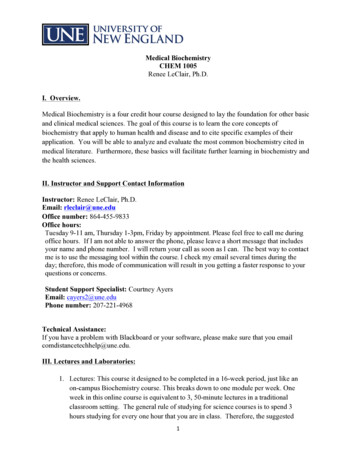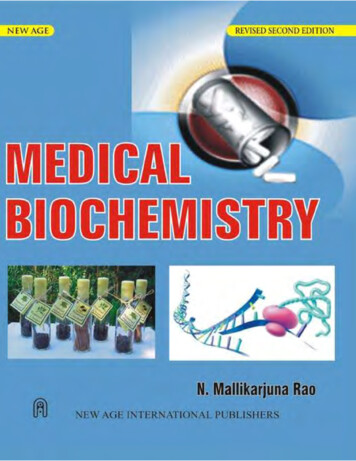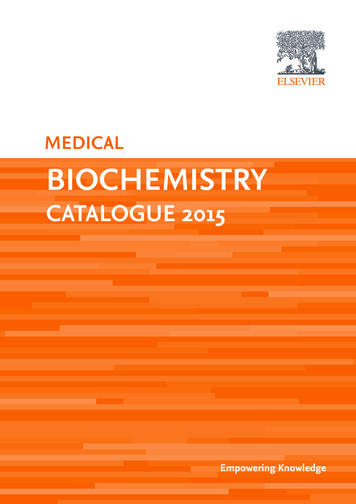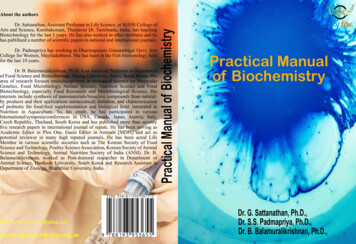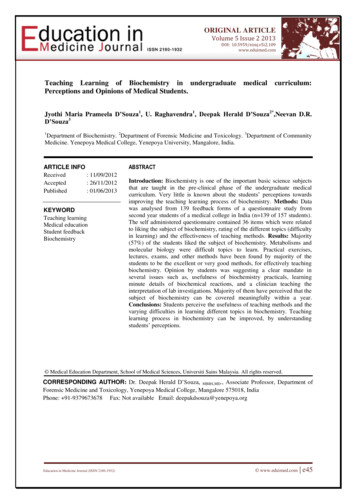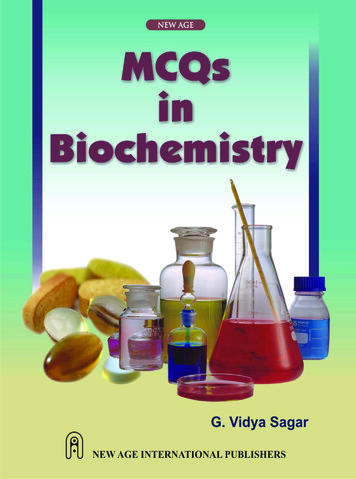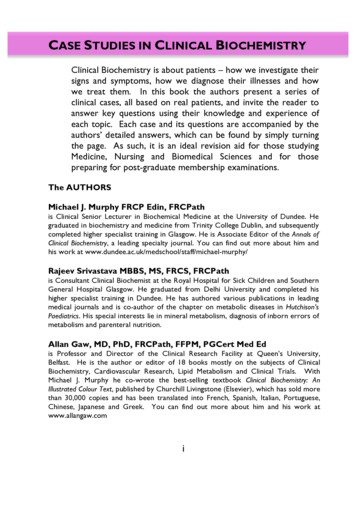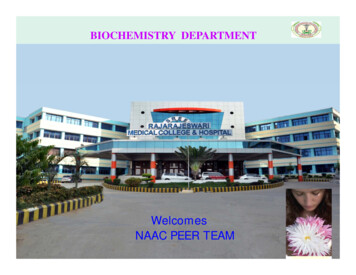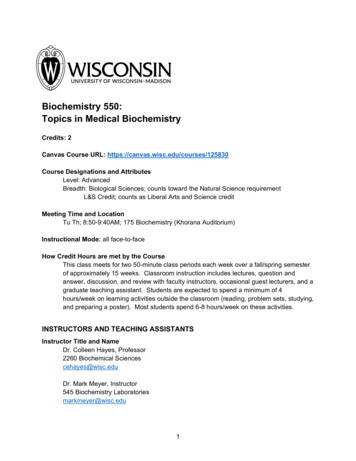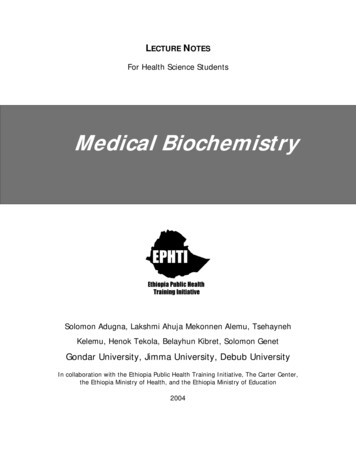
Transcription
LECTURE NOTESFor Health Science StudentsMedical BiochemistrySolomon Adugna, Lakshmi Ahuja Mekonnen Alemu, TsehaynehKelemu, Henok Tekola, Belayhun Kibret, Solomon GenetGondar University, Jimma University, Debub UniversityIn collaboration with the Ethiopia Public Health Training Initiative, The Carter Center,the Ethiopia Ministry of Health, and the Ethiopia Ministry of Education2004
Funded under USAID Cooperative Agreement No. 663-A-00-00-0358-00.Produced in collaboration with the Ethiopia Public Health Training Initiative, The CarterCenter, the Ethiopia Ministry of Health, and the Ethiopia Ministry of Education.Important Guidelines for Printing and PhotocopyingLimited permission is granted free of charge to print or photocopy all pages of thispublication for educational, not-for-profit use by health care workers, students orfaculty. All copies must retain all author credits and copyright notices included in theoriginal document. Under no circumstances is it permissible to sell or distribute on acommercial basis, or to claim authorship of, copies of material reproduced from thispublication. 2004 by Solomon Adugna, Lakshmi Ahuja Mekonnen Alemu, TsehaynehKelemu, Henok Tekola, Belayhun Kibret, Solomon GenetAll rights reserved. Except as expressly provided above, no part of this publication maybe reproduced or transmitted in any form or by any means, electronic or mechanical,including photocopying, recording, or by any information storage and retrieval system,without written permission of the author or authors.This material is intended for educational use only by practicing health care workers orstudents and faculty in a health care field.
Table of ContentsTable of Contents.iAcknowledgement.vIntroduction .viSolomon Adugna and Lakshmi AhujaUnit One: Enzymes .1Henok TekolaPrinciples and classifications of Enzymes .5Mechanism action of Enzymes .7Enzyme Inhibition .13Regulation of Enzyme activity .18Enzymes in clinical diagnosis .19Unit Two: Carbohydrate Metabolism .23Belayhun KibretChemistry of Carbohydrates .23Functions of Carbohydrates .31Digestion and absorption of Carbohydrates .33Glycolysis .35Glycogen Metabolism .42Glycogen storage diseases .45Pentose phosphate pathway .46The Cori - cycle .48Gluconeogenesis .49Unit Three: Integrative Metabolism Bioenergetics .54Tsehayneh KelemuIntroduction .54Structural basis of high energy phosphate .55Formation and utilization of ATP .56Catabolism of fuel molecules .56Concept of Free energy .58Oxidation-reduction reactions .58Aerobic energy generation .61Kreb’s cycle .63Function and regulation of kreb’s cycle .70i
Electron transport system and oxidative Phosphorylation .71Respiratory control .77Uncouplers .77Respiratory poisons .78Unit Four: Lipid Metabolism .80Solomon GenetClassification of Lipids .80Types of Lipids .80Digestion and absorption of Lipids .86Metabolism of Fatty acids and Triacyl Glycerols .88β-Oxidation of Fatty acids .90Metabolism of Ketone bodies .93Biosynthesis of Fatty acids and triacyl glycerols .97Cholesterol Metabolism .99Atherosclerosis .101Hypercholesterolemic drugs .101Lipid storage diseases .102Fatty Liver .102Lipoproteins .102Chemical compositions of Membranes .104Unit Five: Amino acids and Proteins .105Solomon AdugnaClassification of amino acids .106Properties of amino acids .115Peptides .119Glutathione synthesis .121Proteins .124Classifications of proteins .124Levels of organization of proteins .126Denaturation of proteins .131Hemoglobin and Myoglobin .135Sickle cell Hemoglobin .136Sickle cell disease, Sickle cell trait.136Digestion and absorption of proteins .137Amino acid catabolism .141Nitrogen balance, excretion and the urea cycle.144ii
Defects in the urea cycle .150The Glucose - Alanine cycle .151Inborn errors of amino acid metabolism.152Amino acid derived nitrogenous compounds .154Clinical problems .159Unit Six: Vitamins and Coenzymes . .161Solomon AdugnaWater soluble vitamins . .161Chemistry, sources, function and deficiency of:Thamine . .161Riboflavin . .163Niacin . .164Pyridoxine . .165Biotin . .166Cobalamin . .167Folic acid . .169Panthothenic acid. .170Ascorbic acid . .171Fat soluble vitamins . .172Chemistry, Sources, function, deficiency and Hypervitaminosis of:Vitamin A . .173Vitamin D . .177Vitamin E . .179Vitamin K . .181Unit Seven: Miniral Metabolism . .183Lakshmi AhujaMineral . .183Sodium and potassium . .183Calcium and Phosphate . .184Trace elements . .185Iron . .185Copper . .187Magnesium. .188Flourine . .188Iodine . .189Zinc . .189iii
Selenium . .191Unit Eight: Hormones . .193Lakshmi AhujaDefinition and classification . .194Biosynthesis, storage, transport . .196Mechanism of action of steroid hormones . .197Mechanism of action of protein hormones . .198Receptors and diseases . .202Second messengers . .203Insulin synthesis, secretion and metabolic role . .205Diabetes mellitus . .209Symptoms and complications of DM. . .210Glucagon . .211Clinical aspects. .212Thyroxin . .213Synthesis and Metabolism . .213Hypo and Hyper Thyroidism . .214Goiter . .215Catecholamines . .216Pheochromocytoma. .217Case Histories . .217Unit Nine: Molecular Genetics . .220Mekonnen AlemuStructure of Nucleic acids . .220Types of Nucleic acids . .226Replication of DNA . .230DNA Damage and repair mechanism . .231RNA synthesis . .233Post transcriptional Modifications . .236Translation/Protein synthesis . .240Regulation of protein synthesis . .242The Genetic code . .243Post translational processes . .244Glossary . . .246Reference . . .253iv
ACKNOWLEDGMENTThe team of authors from the department of Biochemistry of various Universities would like tothank and express their deep rooted gratitude to the Carter Center (EPHTI) for its initiation anddrive to prepare this teaching material. The Center has not only supported the team financially,but also stood behind it firmly throughout the entire period of this experience. Thus CarterCenter has become the pioneer in the field of preparing teaching material and also in training ateam of authors for future endeavors of the kind.In addition, the task would have been impossible without the directing of the Federal DemocraticRepublic of Ethiopia, Ministry of Education.It is also not out of place to thank the administration of Gondar University, Debub University andJimma University for extending cooperation whenever it was needed.The authors extend their appreciation to Ato Akililu Mulugeta, Manager, Carter Center, who hasshepherded the team’s effort through manuscript to finished pages.The authors are particularly grateful to Abdel-Aziz Fatouh Mohammed (Ph.D) Associateprofessor of Biochemistry, Medical Faculty, Addis Ababa University and Ato. Daniel Seifu,Lecturer of Medical Biochemistry, Medical Faculty, Addis Ababa University for their highlyprofessional editing and most helpful comments about many aspects of the text.v
INTRODUCTION TO BIOCHEMISTRYMedical biochemistry is an essential component of curriculum for all categories of healthprofessionals. Contemporary Biochemistry plays a crucial role in the Medical field, be itmetabolic pathways, storage diseases, mechanism action of varied biomolecules or inter andintra cellular communications.A lecture note on Medical biochemistry integrates and summarizes the essentials of the coresubject. Topics are carefully selected to cover the essential areas of the subject for graduatelevel of Health sciences. The chapters are organized around the following major themes:1. Conformation of biomolecules, structure and their relationship to biological activity2. synthesis and degradation of major metabolites3. Production and storage of energy4. Biocatalysts and their application5. Intercellular communication by hormones6. Molecular events in gene expression and regulationEnzymes:Body proteins perform a large number of functions. One such unique function is, they act asbiological catalysts (Enzymes) .They are responsible for highly complex reactions. They directthe metabolic events and exhibit specificity toward substrates, regulate the entire metabolism.Thus, they play key role in the degradation and synthesis of nutrients, biomolecules etc. Themost important diagnostic procedures involves assay of enzymes. They assist to knowdamaged tissues, the extent of tissue damage, helps to monitor the course of the disease andused as a therapeutic means of diagnosing a vast array of diseases.Amino acids and ProteinsLiving systems are made up of Proteins .They are the dehydration polymers of amino acids.Each amino acid residue is joined by a peptide linkage to form proteins. Proteins are themolecular instruments in which genetic information is expressed, Hormones, Antibodies,transporters, the lens protein, the architectural framework of our tissues and a myriad ofsubstances having distinct biological activities are derived. The type, nature and number ofamino acids impart characteristic properties to the proteins.There are about 300 amino acids, but only 20 are coded by DNA of higher organisms. Acidbase properties of amino acids are important to the individual physical and chemical nature ofvi
the protein. The structural organization of proteins could be primary, secondary, tertiary andquaternary. The three dimensional structure is the most biologically active one.The unfolding and disorganization of the proteins results in denaturation, the process is mostlyirreversible. Such a protein may lose its biological function. Many amino acid derived peptidesare of biological importance and special products formed from them are of critical importance tothe body.CarbohydratesThey are biomolecules, found abundantly in living organisms. They contain more than onehydroxyl group (polyhydric) In addition to aldehyde or ketone group. Thus, they form in topolyhydroxy aldoses or polyhydroxy ketoses. Carbohydrates can be classified in toMonosaccharide, disaccharide, and polysaccharides. Mono is the smallest sugar unit,disaccharide is made up of two monosaccharides joined by glycosidic linkages .The linkage canbe α or β. A polymer with more than 10 monosaccharide units is called polysaccharide.Carbohydrates have a wide range of functions. They provide energy; act as storage moleculesof energy. Serve as cell membrane components and mediate some forms of communicationbetween cells.Absence of a single enzyme like lactase causes discomfort and diarrhea. The failure ofGalactose and fructose metabolism due to deficient enzymes leads to turbidity of lens proteins(Cataract). Blood glucose is controlled by different hormones and metabolic processes. Peoplesuffer from Diabetes if the insulin hormone is less or not functioning well, such people are proneto atherosclerosis, vascular diseases, and renal failure.Integrative Metabolism and BioenergeticsOxygen is utilized for the conversion of glucose to pyruvate. The same metabolite also formsfrom amino acid and protein metabolism. Other precursors like Glycerol, propionate can giverise to pyruvate. The main breakdown product of pyruvate is acetyl CoA, which is the commonintermediate in the energy metabolism of carbohydrates, lipid and amino acids. It enterscentral metabolic pathway, the Citric acid cycle in the mitochondrial matrix. Here it is convertedto CO2, H2O and reduced coenzymes (NADH, FADH2). These reduced nucleotides are thesubstrates for oxidative Phosphorylation in mitochondria, their oxidation provide the energy forthe synthesis of ATP, the free energy currency of cells.vii
LipidsThe bulk of the living matter is made up of Lipids, carbohydrates and proteins.Lipids are water insoluble, but can be extracted with non-polar solvents like Benzene, methanol,or ether.Some lipids act as storage molecules for example triglycerides stored in adipose tissue.Transport forms of lipids (Lipoproteins),are present in combination with proteinsBuilding blocks of lipids are fatty acids. Some lipids like cholesterol lack fatty acids but arepotentially related to them. Lipids are constituents of cell membrane and act as hydrophobicbarrier that permits the entry/exit of certain molecules. Lipids carry fat soluble vitamins and formspecial biomolecules. Lipid imbalance can lead to serious diseases like obesity andatherosclerosis. Break down of fatty acid produce energy, excessive breakdown cause ketosis,ketoacidosis, coma and death.Cholesterol level in blood is controlled by several regulatory mechanisms. Such information isapplied in the treatment of patients with high cholesterol levels.Vitamins and MineralsThey are organic compounds required in small quantities for the functioning of the body. Theyare not synthesized in the body, needed to be provided in the diet. Vitamins do not generateenergy. Generally they are responsible for the maintenance of health and prevention of chronicdiseases. Grossly there are two groups’ Water soluble vitamins are Vit. B-complex and C. Fatsoluble vitamins are Vit A, D, E, and K.Minerals are elements present in human body .Elements like C,H,N are provided by the diet andwater .Second group includes Ca, P, Mg, Na, K. Cl and Sulphur. These are required in largequantities (100mg or more/day). They are called Macro elements.A third group includes trace elements, which are required in small amounts for example Fe, I,Zn, etc.Fluorine deficiency associated with tooth decay, excess of it causes fluorosis. Sources andrequirement are of physiological importance. The metabolic role and deficiency disorders areimportant for the students of health sciences.Vitamins and trace elements are particularly important for patients with gastrointestinaldisorders, who are fed on artificial diets or parenteral nutrition.viii
HormonesHormones are chemical messengers secreted by endocrine glands and specific tissues. Theyreach distant organs and stimulate or inhibit the function. They play important role in carryingmessages to the various organs. They form part of a signaling system.Hormones are synthesized in one tissue, secreted in to blood, transported as mobilemessengers .When they reach target tissue, they exhibit their actions. Defect in the secretion,function, metabolism can lead to various diseases.Molecular BiologyHuman beings are highly developed species. How a person looks, behaves, suffers fromdiseases and the like are dictated by genetic material called DNA. The information is inheritedfrom parent to offspring. The same is replicated from parent DNA to daughter DNA.Individual characters are translated in to proteins, under the direction of DNA. First RNA issynthesized from DNA (Transcription) which is translated in to Proteins. These proteins areresponsible for various metabolic functions. Protein expression during development, adaptation,aging and other related processes of life are controlled by DNA.Changes in the genetic material cause hereditary diseases.ix
UNIT ONEENZYMESGeneral PropertiesEnzymes are protein catalysts for chemical reaction in biological systems. Theyincrease the rate of chemical reactions taking place within living cells with out changingthemselves.Nature of EnzymesMost enzymes are protein in nature. Depending on the presence and absence of a nonprotein component with the enzyme enzymes can exist as, simple enzyme orholoenzyme1. Simple enzyme: It is made up of only protein molecules not bound to any nonproteins. Example: Pancreatic Ribonuclease.2. Holo enzyme is made up o protein groups and non-protein component. The protein component of this holo enzymes is called apoenzyme The non-protein component of the holo enzyme is called a cofactor. IIf this cofactor is an organic compound it is called a coenzyme and if it is an inorganicgroups it is called activator. (Fe 2 , Mn 2 , or Zn 2 ions).If the cofactor is bound so tightly to the apoenzyme and is difficult to remove withoutdamaging the enzyme it is sometimes called a prosthetic groupCOENZYMES-Coenzymes are derivatives of vitamins without which the enzyme cannot exhibit anyreaction. One molecule of coenzyme is able to convert a large number of substratemolecules with the help of enzyme. Coenzyme accepts a particular group removed from the substrate or donates aparticular group to the substrate Coenzymes are called co substrate because the changes that take place insubstrates are complimentary to the changes in coenzymes.1
The coenzyme may participate in forming an intermediate enzyme-substratecomplexExample: NAD, FAD, Coenzyme AMetal ions in enzymesMany enzymes require metal ions like ca2 , K , Mg2 , Fe2 , Cu2 , Zn2 , Mn2 and Co2 for their activity.Metal-activated enzymes-form only loose and easily dissociable complexes with themetal and can easily release the metal without denaturation. Metalloenzymes hold themetal tightly on the molecule and do not release it even during extensive purification.Metal ions promote enzyme action bya. Maintaining or producing the active structural conformation of the enzyme(e.g. glutamine synthase)b. Promoting the formation of the enzyme-substrate complex (Example: Enolase andcarboxypeptidase A.)c. Acting as electron donors or acceptors (Example: Fe-S proteins and cytochromes)d. Causing distortions in the substrate or the enzyme Example: phosphotransferases).Properties of EnzymeA. Active siteEnzyme molecules contain a special pocket or cleft called the active site. Theactive site contains amino acid chains that create a three-dimensional surfacecomplementary to the substrate.The active site binds the substrate, forming an enzyme-substrate (ES) complex.ES is converted to enzyme-product (EP); which subsequently dissociates to enzymeand product.For the combination with substrate, each enzyme is said to possess one or more activesites where the substrate can be taken up.The active site of the enzyme may contain free hydroxyl group of serine, phenolic(hydroxyl) group of tyrosine, SH-thiol (Sulfhydryl) group of cysteine or imindazolle groupof histidine to interact with there is substrates.2
It is also possible that the active site (Catalytic site) is different from the bindingsite in which case they are situated closely together in the enzyme molecule.B. Catalytic efficiency/ Enzyme turnover numberMost enzyme- catalyzed reactions are highly efficient proceeding from 103 to 108 timesfaster than uncatalyzed reactions. Typically each enzyme molecule is capable oftransforming 100 to 1000 substrate molecule in to product each second.Enzyme turn over number refers to the amount of substrate converted per unit time(carbonic anhydrase is the fastest enzyme).C. SpecificityEnzymes are specific for their substrate. Specificity of enzymes are divided into:a. Absolute specificity:- t
INTRODUCTION TO BIOCHEMISTRY Medical biochemistry is an essential component of curriculum for all categories of health professionals. Contemporary Biochemistry plays a crucial role in the Medical field, be it metabolic pathways, storage diseases, mechanism action of varied biomolecules or inter and intra cellular communications.
